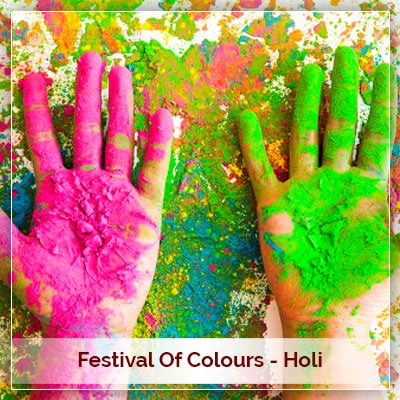Holi Festival of Colours – Rangwali Holi OR Dhulandi on 25th March 2024
Published On : February 28, 2018 | Author : Astrologer Pt Umesh Chandra Pant 
What Is Holi, And Other Details Surrounding This Festival
History of Holi festival of Colours
Liveliness is an eternal part of an age-old Sanatana tradition which has its roots in India. When the evil forces start dominating on Earth and the negativity goes beyond its peak, the supreme lord himself manifests on Earth in various forms or incarnations. The manifestation of Lord Narasimha is also one of such Avataras. The actual history of this festival is very ancient and this is now celebrated in many countries around the world in a grand manner. Even many non-Hindus can be seen colored in various shades by celebrating the festival this day. This is one of the most attractive festivals of the spring season which attracts many people towards it. The whole world is full of colors; it will be hard to find a person who does not enjoy the brightness of colors. Despite the distance, location, culture, and religious restrictions, this festival is capable of transcending all the barriers to incorporate various people into it. From the history, we can see that the kings and laymen both celebrated this festival in their respective ways in different places. In the history, we find mention of Holiyari toil, Vasant jhoola, raagini, and poems etc which talk about this festival of colors. Apart from this, the mention of Holika burning and playing with colors is found in many ancient texts, inscriptions in historical places, and also in the stone inscriptions of some ancient temples which confirm that it was celebrated in a very grand manner in the past as well. In many Puranic texts like Narada and Bhavishya Purana, we find the mention of the story of Prahalad and event of Holika burning along with incarnation of Lord Narasimha. Want to know astrological effects on your birthday.
In the ancient and modern Sanskrit and Hindi literature, we find mention of Holi whenever there is a mention of Vasant (spring). Folklore and literature also talk about the festival of colors along with the story of Lord Krishna with Radha. Holi festival of colours is mentioned in various regional poems in the forms of Holi of Barsana, Vrindava, Faag of Uttar Pradesh, Holi (colourful festival) festival of Haryana, Rajasthan, Gujarat, Bihar, Assam, Nepal etc. In many prose and poetry, we find mention of the regional festival of Holi, festival of India in a unique way. Apart from that, many poets of the Bhakti era have also sung the glory of Lord by mentioning of play of colors between Gopa and Gopis and lord himself in a very special and devotional way.
The great tradition of Holi and its cultural values
Holi (colourful festival) is an ancient and traditional festival of India. There are some preparatory customs which are done before the Holika burning and color festival. Around eight days before the festival, the preparations can be actively seen on a social level. The signal of season change from winter to summer is by the ripening of the harvest of various agricultural products. People collect the harvest and store in their house or at suitable places. As per the tradition, a wooden stick with a flag is put up on the ground in an upright position. This is done before eight days of Holi festival of India as an indication of the arrival of Holi. This period is called as Holashtak. The wooden stick is put up in the ground with traditional worship and customs with relatives and neighbors. Around the wooden bar or stick, people slowly start gathering some big and small wooden pieces, dried grasses, and cow dung cakes, etc. This also helps in organizing the harvested crops in a better way and unwanted woods and grass are utilized for Holika burning. During the eight days period before the holi (holashtak) one should not perform auspicious ceremonies like marriage, housewarming, new ventures, pilgrimages etc. After collecting all the woods and cow dung cakes etc. Finally, the Holika burning (collected woods) is performed in the evening at a suitable time as per muhurta. The remnants of barley and gram crops are also used along with dried coconuts and dried cow dung balls are tied in a jute rope. Along with this, pooja material like milk, yogurt, ghee, vermilion, turmeric, rice, water, and sweets are collected for the pooja. During the muhurta, the pooja is performed with these items along with setting up the fire. Everyone performs the pooja of this sacred burning fire with devotion and also performs some circumambulations around the Holika fire. Ripe crops of barley etc. are roasted in the fire by tying it with a long stick. This is known as “Hoomi Hora” by common people. Generally, the circumambulations are to be done in odd numbers around the fire. During the burning ceremony of Holika, there is a tradition of singing special folk songs and religious hymns by holihars who are specialized in this type of singing. Is the marriage life not helpful? Do you experience frequent strife or tension? Ask for Marriage Report and solve your marital issue positively.
As per the Shastras, Holika Dahan (burning) can be performed after the twilight of the evening (pradosha kaala) and Bhadra muhurta is to be avoided for this ceremony. This because of a belief that if Holika is burnt during Bhadra (inauspicious time) then it would bring unwanted natural calamities and other problems to that region or country. Hence wise people advise performing Holika Dahan any time but with the exclusion of Bhadra. Scriptures talk of high merits of performing Holika Dahan and performing Parikrama around the burning fire. In the Puranic literature, we find stories related to Holika. It is mentioned that she was the sister of Hiranyakashipu who was the father of Prahalad. This story is a great example of the victory of truth and devotion over evil forces. Because of untoward inclination against god and truth, the inner nature of demon Hiranyakashipu had become devoid of generosity and truthfulness. Because of his demonic instincts, he rejected gods and started to proclaim himself as a god. There are few other stories related to Prahalada found in the Puranas. As per another legend, Lord Krishna killed Putana on the same day. Elated with this, all the Gopas of Gokul and Vrindavan celebrated this victory of Lord Krishna by putting colors on each other. Hence Holika Dahan is an emblem of victory of truthfulness over the evil and falsehood. On the night of Holika burning, people celebrate with drums and other musical instruments. There are many special folk songs for this special event as well.
Holi and Music
During Holi, it is common to hear many folk songs and new musical songs of the movies being played or sung at various places. People enjoy various types of music, be it the music played on the televisions, radios etc. Regional songs and music like Bhangra of Punjab, or traditional Faag of Uttar Pradesh, people could be found immersed in musical events during this festival. Folk songs and traditional songs are sung at many places and local artists also play some musical instruments and there are various dance performances as well. The public can be seen extremely involved to participate in such traditional events of music. Holi is an occasion which values the unity of the family as well social unity amongst the people. This is a festival of the spring which brings light to the people who are surrounded by darkness in their lives. The atmosphere during Holi fills the mind of people with cheerfulness, positivity, and creativity and inspires them to achieve their goals.
Holi: The magnificent festival of colors
The next day after choti holi is the day of Rangoli or Colors. It is also known as Dhuleti or Dhulandi. This festival has to be celebrated every year on the pratipada after the Poornima of Phalguna month. This is also the celebration of the spring season which brings colors and nourishment to flora and fauna. To celebrate this season of color, people apply color on each other as a mark of love and affection. This enhances the feeling of love and forgiveness amongst the people. Past disputes and grudges are resolved with the colorful festival of love and happiness. Applying color to the dear ones is considered very auspicious and affectionate. Various milk sweets, dry fruit sweets, and savories are prepared specially for this festival and are exchanged with the relatives and friends. The atmosphere on this day is so colorful and lively that even elderly people start feeling energetic and happier even they cannot stop themselves from participating in the play of colors. However, it is not correct to behave in a rude or vulgar manner during the festival. Youth should participate in the festival with positive mind and sincerity. As a mark of respect, younger people apply color to the elders and touch their feet with respect. A variety of colors and music not only attracts people towards the festival but also instills positivity and creativity in the hearts of people. Though this festival is actively celebrated by people throughout the country, the residents of bigger cities usually prefer to play with colors from morning until the early afternoon so that they can have a bath and they can visit their dear ones after wearing new garments. Hence, this festival is celebrated for 2-3 day in some places and even up to 15 days in some rural areas. People celebrate it in different ways for different duration of time. Among these traditions, the Holi of Barsana and Vraj region is very famous for its unique way of celebration called as “Lath-maar Holi” in this, men put colors on women, and women beat men with soft sticks made of cloth or soft wood. This festival is extremely eye-catching in Mathura which is the birthplace of Sri Krishna. It is celebrated in many states like Bihar, Rajasthan, Haryana, and Tamil Nadu and also in neighboring country Nepal. People enjoy the maximum during this fun-filled festival by dancing on the drum beats, singing humorous songs, playing in groups, drinking a variety of flavored drinks and with special dishes on this occasion.
The Puranic legend of Holika Dahan
There are many interesting stories in the scriptures on Holika and Holika Dahan. As per the legend, Prahalada was an ardent devotee of Lord Sri Hari, he had surrendered himself to the lord and was engaged in his bhakti. But unfortunately, his father Hiranyakashipu did not like his religious nature and always used to stop him from God’s worship. He was against Lord Vishnu and was extremely egoistic and violent in nature. He had the ego because of his powers and possessions. He had eventually developed a strong hatred towards Sri Vishnu in his heart. He started thinking himself as the god. He was against Vedic gods, Brahmins, and Vedic sacrifices etc. But in his house, a pious soul was born as his son whose name was Prahalada. From very early childhood, Prahalad was a dedicated devotee of Sri Vishnu. Once his father Hiranyakashipu got furious over Prahalad’s god worship and threatened him to stop it immediately. But the child was firm in his devotion and continued to pray to Lord Sri Hari. As a result, Hiranyakashipu decided to punish the child by ending his life. He asked his soldiers to throw Prahalada in front of a mad elephant but to their surprise, the elephant did not harm the child instead he placed him on his back and child started playing innocently. Hiranyakashipu tried many such ways to kill Prahalad but he was mysteriously saved every time. Frustrated by this, he decided to burn him alive in the fire. He requested his sister Holika to carry young Prahlada on her lap and sit in the fire. As Holika was given a boon that she would not burn in the fire she took the child in her lap and fire was set. But as soon as the flames became dense, the child was unaffected by the fire and on the contrary, Holika started burning, and eventually, she was completely burnt in the fire. As a symbol of victory of true devotion to evil intentions, this festival is celebrated throughout the country as Holi or Rangoli etc.
As per the Puranic and tantric tradition, this night of Holika burning is one of the four important nights (Siddha Ratri) which is considered extremely powerful time towards getting siddhis of various mantras, yantras, and kavachas. Items such as Original and Authentic Rudraksha and Powerful Yantra empowered during this special and sacred night have a very high degree of potency. Get a detailed yearly finance report from expert Online Astrologer India at Pavitra Jyotish
Holi Pooja Muhurta for 2023
This year, Holika Dahan and poojan will be done during the evening (pradosha kaal) of Sunday, 25th March 2024 (Phalguna Shukla Poornima). Devotees should try to perform the Holika poojan with various commonly used items in poojas. The color festival will be celebrated in a grand manner on the next day, Chaitra Krishna Paksha Pratipada with colors of joy throughout the country and across the world.
Holika Dahan on 24th March 2024 (Sunday)
Holika Dahan Muhurat: 11:13 pm to 12:27 Am
Duration: 1 Hour 14 Minute
Rangwali Holi OR Dhulandi on 25th March 2024 (Monday)
Pavitrajyotish.com is providing guidance and solution to the customer contacting us. We have been successfully providing assistance using principles, provision of Vedic Astrology since last 19 years. Accuracy and reliability are our main concern.
Do you know most bad results in life are caused by malignant planets? Pacify them with Navgrah Shanti Anushthan.
Must Read: Lord Shri Krishna and Akshay Tritiya Festival







